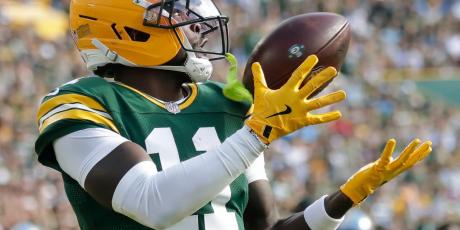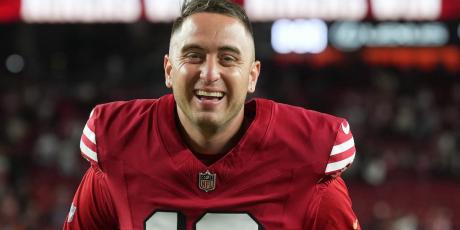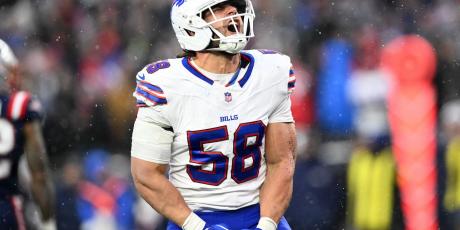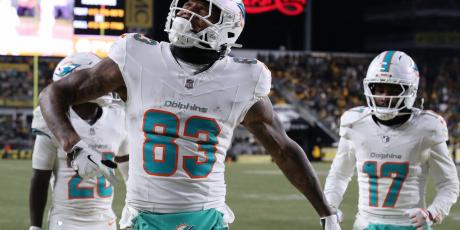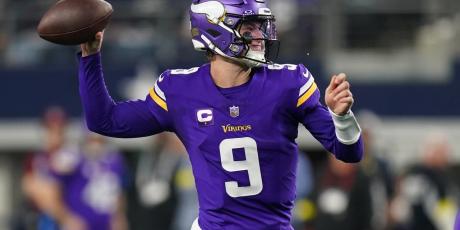Streaming Defenses Works and Here's How to Do It

Streaming defenses is one of the best strategies in fantasy football—and it's becoming more popular.
For those unfamiliar, to stream your defense is to avoid worrying about its long-term outlook or using a high draft pick on one because you're instead going to acquire the defense with the best matchup available on the waiver wire each week.
More 2018 Positional Draft Strategies: IDP | TE | QB | WR | RB
D/ST Draft Strategy: Why Streaming Defenses Works
In seasons past, it was a popular practice to just use the final rounds of your draft to fill out your roster by picking the best defense(s) available. However, there are now only a handful of dominant defenses, and even they are capable of putting up a fantasy dud in any given week due to the variance inherent to the position. The modern-day NFL has evolved and the rules now strongly favor quarterbacks and high-scoring offenses.
According to MyFantasyLeague ADP, the New Orleans Saints were the first defense to come off the board in 2017, with an ADP of 97.15 (which is around the eighth round of a 12-team draft). At that spot, you could've taken Matthew Stafford (99.17), DeSean Jackson (97.25), or Adam Thielen (109.58). The Saints defense finished seventh at the position with an average of 9.7 fantasy points per game—not nearly as valuable as Thielen, who averaged 16.4 fantasy points per game (PPR) and finished as the WR9. Matthew Stafford averaged 22.4 FPs/game and finished as the QB5.
The point of streaming is to load your roster up with high-upside or consistent producers and then use your last pick on a defense to stream in Week 1. Studying 2017 ADP makes it clear why spending an early pick on a defense can be a mistake:
| Rank | Team | ADP | FPs | FPs/G |
| 1 | JAX | 148.00 | 226 | 14.1 |
| 2 | BAL | 169.17 | 196.5 | 12.3 |
| 3 | LAR | 151.61 | 178.5 | 11.2 |
| 4 | PHI | 148.69 | 167 | 10.4 |
| 5 | DET | 163.5 | 10.2 | |
| 6 | LAC | 186.43 | 160.5 | 10 |
| 7 | NO | 97.15 | 155 | 9.7 |
| 8 | SEA | 113.12 | 154.5 | 9.7 |
| 9 | CHI | 213.96 | 145.5 | 9.1 |
| 10 | PIT | 141.96 | 145 | 9.1 |
| 11 | CAR | 141.10 | 139 | 8.7 |
| 12 | MIN | 122.08 | 132 | 8.3 |
| 13 | KC | 109.95 | 128.5 | 8 |
| 14 | NE | 121.66 | 127.5 | 8 |
| 15 | DAL | 191.31 | 126.5 | 7.9 |
| 16 | BUF | 167.88 | 126.5 | 7.9 |
| 17 | WAS | 121 | 7.6 | |
| 18 | ARI | 129.62 | 117.5 | 7.3 |
| 19 | TEN | 159.18 | 114 | 7.1 |
| 20 | TB | 184.37 | 111.5 | 7 |
| 21 | DEN | 102.27 | 111 | 6.9 |
| 22 | GB | 180.32 | 103.5 | 6.5 |
| 23 | CIN | 185.94 | 102 | 6.4 |
| 24 | ATL | 155.50 | 100.5 | 6.3 |
| 25 | HOU | 118.40 | 100 | 6.3 |
| 26 | MIA | 199.85 | 95.5 | 6 |
| 27 | NYG | 153.79 | 95 | 5.9 |
| 28 | SF | 212.16 | 89.5 | 5.6 |
| 29 | IND | 88 | 5.5 | |
| 30 | NYJ | 83.5 | 5.2 | |
| 31 | CLE | 211.64 | 72.5 | 4.5 |
| 32 | OAK | 177.56 | 69.5 | 4.3 |
The Lions went mainly undrafted and they finished as the DST5 (depending on your scoring). The Jaguars finished as the top-scoring defense and were drafted four rounds later than the Saints. The Patriots are a defense which continues to be over-drafted. The Bears, Ravens, and Lions outperformed the Patriots last seasob and provided better value comparing their ADPs. The Lions could have been your last pick and scored just as many points as a defense taken 10+ rounds earlier—and that's without even streaming.
So far, drafters are buying into the Jaguars early and their early ADP of 97.10 (early eighth round in 12-team leagues) reflects that. An early look at ADP shows the Cardinals, Lions, Falcons, and Buccaneers to be solid late-round streaming targets.
When streaming a defense, there are four factors I take into consideration...
FREE DOWNLOADABLE BONUS: Get a sneak peak at 16 of our data-driven, actionable articles: 20 Sleepers, Busts and Breakouts!
1. NFL Stats That Indicate How Good/Bad an Offense Is
More times than not, picking on a bad offense is going to work in your favor. Last season, the Browns and Rams were two offenses we could pick on and expect top-10 results from our defense. Bad offenses tend to have bad quarterback play, below-average offensive lines, and few offensive weapons. Those factors combined result in few points allowed and big plays for the defense—namely sacks, turnovers, and touchdowns.
In the context of the matchup for a fantasy defense, there are three main statistics that provide a good indication of how good or bad an offense is:
Points Per Game
Nothing signals a bad offense more than being one that fails to score many points. In 2017, these were the bottom-five scoring offenses in terms of points per game:
- Browns: 14.6 (though, the offense should be improved in 2018)
- Giants: 15.4
- Colts: 16.4
- Bears: 16.5
- Dolphins: 17.6
I think one of the offenses we can target with defenses in 2018 will be Buffalo since they'll be starting either A.J. McCarron, Nathan Peterman, or Josh Allen.
Turnover Differential
Targeting offenses that have negative turnover differentials provides upside because turnovers are the plays where defensive touchdowns can occur. Here are the bottom-five offenses in that category in 2017:
- Browns: -28
- Broncos: -17
- Dolphins: -14
- Raiders: -14
- Texans: -12
Those five offenses were the only ones with a double-digit negative turnover differential.
Pressure Rate
Sacks are prone to regression, but we can use pressure rate to help project sacks; pressures tend to turn into sacks, which lead to fantasy points for our defense. According to FootballOutsiders, these offenses had the highest-allowed pressure rates in 2017:
- Texans/Colts/Seahawks: 36.9%
- Vikings: 36.1%
- Packers: 35.1%
- Redskins: 34.9%
- Eagles: 34.3%
- Jaguars: 33.2%
- Browns: 32.9%
- Bills: 32.7%
The Browns have added a few pieces and parts to their offense which should allow them to score a few more points this upcoming season. Joe Thomas retired this offseason, though, so they lost a Hall of Fame left tackle to protect Tyrod Taylor. The Texans' turnover rate should improve, as it appears Deshaun Watson will be ready for the 2018 season.
2. The NFL Injury Report
Injuries on the both sides of the ball are key to monitor. Below are three main injuries to look out for.
Injury to the Quarterback
The NFL is a quarterback-driven league, so if an offense has to start their second- or third-string quarterback, the opposing defense quickly jumps to the top of the streaming list. Backup quarterbacks have a propensity to hold the ball longer, which leads to more sacks and fumbles. And mounting pressure can also lead to errant throws which are increasingly likely to result in interceptions.
Injury to a Key Offensive Contributor
If a team has lost one of its key offensive contributors, the defense will tend to key in and expose his replacement of lesser talent. Last season, the Cardinals lost David Johnson and their offense just couldn't recover. They went from a top-five offense in 2016 to a bottom-five offense in 2017—dropping a full yard per game in rushing yard average.
Injury to a Defensive Player
Injuries on the defense is also important. If one of the defenses you're considering is without their best pass-rusher or cornerback, that could mean less opportunity for big plays.
3. Fantasy Points Allowed Adjusted for Strength of Schedule
I love our aFPA tool and use it often as a deciding factor when targeting defenses. Adjusting fantasy points allowed for strength of schedule compares matchups on an equal playing field—if a defense has a particularly easy or difficult schedule, their fantasy points allowed are adjusted so that any schedule bias is removed. When looking at aFPA, I recommend sorting from strongest to weakest and starting from there when deciding on defenses to target.
Here were the five offenses that allowed the most aFPA to the DEF/ST position in 2017:
- Browns: 13.6
- Broncos: 13.5
- Texans: 11.0
- Dolphins: 10.0
- Cardinals: 9.8
4. Home-Field Advantage
I factor in home-field advantage for a defense less strongly than other factors, but it's still something I consider when scouring the wire for a defense. Out of the 109 defensive suggestions to appear in my weekly streaming column last season (available to 4for4 subscribers), I picked the home team 61 percent of the time. Whether a defense is at home or away, I like to look at their opponents' Vegas implied team total. For example, if I was faced with the decision of whether to select the Cardinals defense on the road against the 49ers or the Raiders defense at home against the Chiefs, I'd compare the implied team total of the 49ers to that of the Chiefs. If you really like a defense that happens to be on the road, don't let the fact that another available option is at home sway your decision too much.
Photo by Mark Brown/Getty Images.
Related Articles
- 2018 IDP Rankings Breakdown
- 8 Breakout Linebackers to Target in 2018 IDP Leauges
- 9 Breakout Defensive Linemen to Target in 2018 IDP Leagues







